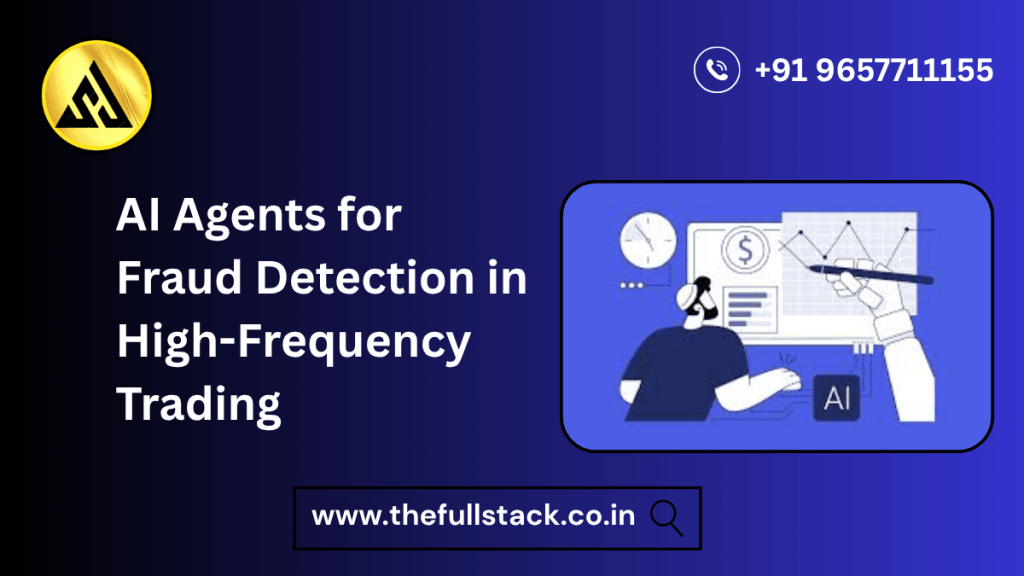In today’s hyper-connected financial world, speed is everything. High-Frequency Trading (HFT) firms execute thousands of trades in fractions of a second. While this creates opportunities for big profits, it also opens the door to one of the most dangerous risks in modern finance—fraud.
How do you monitor millions of trades happening in milliseconds? Human oversight is simply not enough. Enter AI agents—intelligent digital watchdogs designed to identify suspicious activities in real time. These agents combine machine learning, data analytics, and automation to safeguard financial markets without slowing down the trading process.
Whether you’re a beginner exploring financial literacy or a company professional learning how trading systems are protected, understanding AI agents for fraud detection is essential for long-term success.
⚡ What Is High-Frequency Trading (HFT)?
Let’s start simple. High-Frequency Trading is the use of algorithms and high-speed computers to execute thousands—or even millions—of trades within milliseconds.
- Traders profit by spotting small price differences.
- The faster the system, the higher the profit potential.
- Risk: with speed and volume comes the possibility of fraudulent or manipulative trades going unnoticed.
🤖 What Are AI Agents in Trading?
Think of AI agents as digital detectives. Unlike static rule-based systems, AI agents learn, adapt, and act on real-time data.
Key Features of AI Agents in Fraud Detection:
- Continuous Monitoring – Scanning thousands of trades per second.
- Pattern Recognition – Identifying unusual patterns that could signal fraud.
- Adaptive Learning – Getting smarter with every new data input.
- Automated Alerts – Flagging or even blocking suspicious activities instantly.
These aren’t just passive tools—they’re autonomous, intelligent assistants.
🔍 Why Fraud Is a Major Challenge in HFT
Fraud in trading doesn’t always look obvious. Here are some common forms:
- Spoofing – Placing fake orders to manipulate market prices.
- Wash Trading – Buying and selling the same asset to inflate volume.
- Quote Stuffing – Overloading the market with rapid orders to confuse rivals.
- Insider Trading – Exploiting non-public information for profit.
With trades happening in microseconds, fraudsters can execute and cancel orders before traditional monitoring systems even react. That’s where AI-powered fraud detection steps in.
📊 How AI Agents Detect Fraud in Real Time
Here’s how AI agents act as fraud-fighters in HFT:
- Data Analysis at Scale – They analyze massive transaction datasets instantly.
- Behavioral Analytics – AI compares current activity against historical trading patterns.
- Anomaly Detection – Spotting trades that deviate from normal market behavior.
- Predictive Modeling – Forecasting suspicious activity before it escalates.
- Automated Interventions – Some agents can block fraudulent trades automatically.
In essence, AI agents protect the market’s integrity without slowing down speed—a critical requirement in HFT.
🌍 Real-World Applications of AI Agents in Trading
- Stock Exchanges – Deploying AI to monitor large-scale trading flows and prevent market manipulation.
- Investment Banks – Using AI to detect insider trading risks across global networks.
- Retail Platforms – Protecting everyday investors from fraudulent bots.
- Crypto Trading – Detecting fraud in decentralized, high-speed crypto exchanges.
💡 Beginner-Friendly Analogy: The Airport Security System
Imagine airport security. Thousands of passengers enter daily, but security systems are designed to flag suspicious behavior instantly. You don’t have to open every bag—you just identify the patterns of risk.
AI agents in trading work the same way: scanning millions of “passengers” (trades) and isolating the ones that might cause harm.
📈 Market Trends: Why AI Agents Are Growing
- Global Investment in AI for Finance: Expected to cross $35 billion by 2026.
- AI + Regulation: Regulators worldwide are encouraging AI for compliance.
- Crypto Boom: Decentralized markets require smarter fraud detection.
- Data Explosion: The more data grows, the more valuable AI agents become.
By 2025, AI-driven fraud detection will be standard, not optional.
🧭 Practical Tips for Beginners
If you’re new to this space, here’s how to get started:
- Learn the Basics of AI – Understand machine learning and algorithms.
- Explore Financial Fraud Cases – Study how fraud works in real markets.
- Follow Market News – Stay updated on regulatory changes.
- Experiment with Tools – Platforms like Kaggle offer datasets to practice fraud detection.
- Upskill Continuously – Take courses on AI in finance to boost your career.
🚀 Why This Matters for Your Future
Whether you’re an aspiring trader, a financial professional, or just starting your financial literacy journey, understanding AI agents in fraud detection is key.
- Traders gain confidence knowing markets are protected.
- Companies save billions in potential fraud losses.
- Regulators benefit from more transparent systems.
And for you as a learner—this is a career opportunity in AI, trading, and risk management that is only going to grow.
✅ Call-to-Action
The future of trading isn’t just about speed—it’s about trust and security. AI agents are at the center of this revolution.
👉 Ready to learn more? Explore our advanced resources and AI in finance courses on our website today. Equip yourself with skills that ensure long-term financial success in a rapidly evolving market.
You may be also like this:-
What is SQL? A Simple Guide to Databases and Queries

